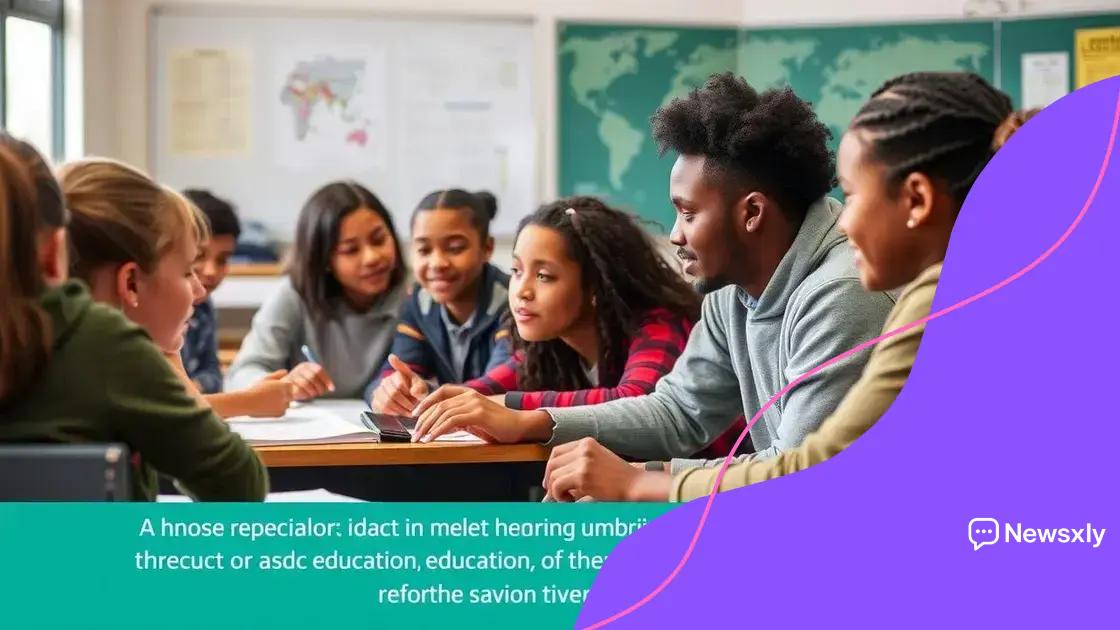Schoolreform: How changes can shape future education

School reform focuses on improving educational quality by integrating technology, emphasizing social-emotional learning, and personalizing education to meet the diverse needs of students.
Schoolreform is more than just a buzzword; it’s a crucial movement aimed at transforming education. Have you ever wondered how these changes could enhance learning experiences for students? Let’s dive into the world of educational reform and its implications.
Understanding the need for school reform
Understanding the need for school reform is vital for improving our education system. As society evolves, so do the challenges faced by students and teachers alike. It’s important to recognize how these changes can benefit everyone involved.
Why is school reform necessary?
There are several reasons why school reform is urgently needed. Many schools struggle with outdated methods and lack resources, which can hinder student learning. For instance, a curriculum that doesn’t reflect modern knowledge or skills can leave students unprepared for the future.
Additionally, schools need to adapt to changes in society, such as technological advancements and shifts in cultural expectations. When we talk about school reform, we often refer to changes that help create a more equitable learning environment.
What are the benefits of reform?
The benefits of school reform can be significant. Students thrive in an environment that is supportive and responsive to their needs. By implementing innovative practices and policies, schools can provide tailored support for each learner.
Improving not just academics but also social and emotional learning is crucial. When students feel valued and understood, they are more likely to succeed. Ultimately, school reform is about creating schools that meet the needs of all students, ensuring that no one is left behind.
Key components of effective school reform
Understanding the key components of effective school reform helps educators and policymakers create lasting change. These components are crucial to building a successful educational framework that meets the needs of today’s students.
Curriculum Development
A well-structured curriculum is a fundamental part of school reform. It should be relevant and adaptable to prepare students for a rapidly changing world. An effective curriculum engages students and promotes critical thinking.
Furthermore, evaluation of student performance should be ongoing. This ensures the curriculum remains effective and relevant to student needs.
Teacher Training and Support
Another essential component is providing teachers with the necessary training and resources. Continuous professional development allows teachers to stay updated on the latest educational strategies and tools. When teachers feel supported, they can better assist their students.
By investing in teacher development, schools can foster a positive learning environment where both educators and students thrive. Effective school reform hinges on the quality of instruction delivered in the classroom.
Community and Parental Involvement
Finally, engaging the community and parents in the education process is vital. When families and communities work together with schools, students benefit from a stronger support system. Programs that promote collaboration can enhance student success.
Involving parents and the community in school reform leads to a more holistic approach to education, benefiting everyone involved.
How school reform impacts student success

Understanding how school reform impacts student success is essential for educators and policymakers alike. When schools undergo reform, they create an environment that can significantly enhance learning outcomes for students. This transformation can lead to improved academic results and better overall experiences.
Improved Learning Environment
A transformative school reform often results in a more positive learning environment. This can mean smaller class sizes, upgraded facilities, and access to modern resources. When students feel comfortable in their surroundings, they are more likely to engage and participate actively in their education.
Such changes can lead to higher levels of motivation among students, which is a key factor in achieving academic success.
Tailored Learning Approaches
Effective school reform also encourages tailored learning approaches. This means recognizing that each student learns differently. By adopting customized teaching methods, schools can address the unique needs of their students. Differentiated instruction and personalized learning are essential in ensuring that every student can succeed.
When students receive the right support, they are more likely to reach their full potential.
Increased Engagement and Motivation
One of the most significant impacts of school reform is the increase in student engagement. When reforms incorporate student voices in decision-making, learners feel valued and are more invested in their education. Engagement often leads to improved attendance and higher achievement.
Such involvement builds a strong sense of ownership over their learning, driving success in academic endeavors.
Challenges in implementing school reform
Implementing school reform comes with several challenges that can hinder progress. These obstacles must be addressed to ensure successful implementation and lasting change in the educational system. Understanding these challenges is essential for educators and policymakers.
Resistance to Change
One major challenge is resistance to change from various stakeholders. Teachers, parents, and even students can be hesitant about new methods or policies. This resistance can slow down the reform process, making it hard to achieve desired outcomes.
To overcome this resistance, it is crucial to engage stakeholders early in the reform process and demonstrate the benefits of the proposed changes.
Limited Resources
Another significant barrier is the lack of resources. Schools often struggle with insufficient funding, leading to inadequate training, materials, and support for teachers. Without proper resources, reforms may falter, and students may not receive the quality education they deserve.
Effective school reform requires a commitment to securing the necessary funding and resources to achieve its goals.
Policy and Bureaucracy
Policy complexities and bureaucratic red tape can also slow down the reform process. State and federal regulations may limit flexibility, making it difficult for schools to adopt new practices quickly.
Addressing these bureaucratic challenges often necessitates collaboration between school leaders, policymakers, and community members to create a streamlined approach.
Future trends in educational reform
Exploring future trends in educational reform reveals exciting possibilities for enhancing student learning. As technology advances and societal needs evolve, schools are poised to adapt uniquely and effectively.
Integration of Technology
One prominent trend is the increased integration of technology in the classroom. Schools are leveraging digital tools to create engaging learning experiences. This integration can lead to personalized education and facilitate collaboration among students.
With technology, education can become more interactive and relevant to students’ everyday lives.
Emphasis on Social-Emotional Learning
Another key trend is the growing focus on social-emotional learning (SEL). Schools recognize that addressing emotional well-being is as important as academic success. By prioritizing SEL, schools help students develop critical life skills.
As a result, students are better prepared to handle challenges inside and outside the classroom.
Personalized and Competency-Based Education
The move toward personalized and competency-based education is another significant trend. This approach allows students to progress at their own pace, mastering skills before moving on to new concepts. Education reform in this direction focuses on individual learning pathways.
By empowering students, schools can foster a sense of ownership over their learning and improve overall outcomes.
FAQ – Frequently Asked Questions about School Reform
What is the main goal of school reform?
The main goal of school reform is to improve the quality of education and ensure that all students receive the support they need to succeed academically and socially.
How does technology play a role in school reform?
Technology enhances learning by providing students with access to digital tools, resources, and interactive experiences that foster engagement and collaboration.
Why is social-emotional learning important?
Social-emotional learning helps students develop critical life skills, such as emotional regulation and empathy, which are essential for personal and academic success.
How can parents and communities support school reform?
Parents and communities can support school reform by actively participating in school activities, providing feedback, and advocating for necessary changes to improve education.





